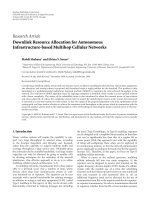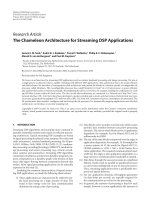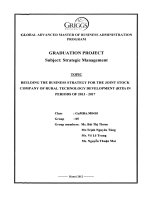Research in the decision sciences for innovations in global supply chain networks
Bạn đang xem bản rút gọn của tài liệu. Xem và tải ngay bản đầy đủ của tài liệu tại đây (9.86 MB, 323 trang )
AboutThiseBook
ePUBisanopen,industry-standardformatforeBooks.However,supportofePUBand
itsmanyfeaturesvariesacrossreadingdevicesandapplications.Useyourdeviceorapp
settingstocustomizethepresentationtoyourliking.Settingsthatyoucancustomizeoften
includefont,fontsize,singleordoublecolumn,landscapeorportraitmode,andfigures
thatyoucanclickortaptoenlarge.Foradditionalinformationaboutthesettingsand
featuresonyourreadingdeviceorapp,visitthedevicemanufacturer’sWebsite.
Manytitlesincludeprogrammingcodeorconfigurationexamples.Tooptimizethe
presentationoftheseelements,viewtheeBookinsingle-column,landscapemodeand
adjustthefontsizetothesmallestsetting.Inadditiontopresentingcodeand
configurationsinthereflowabletextformat,wehaveincludedimagesofthecodethat
mimicthepresentationfoundintheprintbook;therefore,wherethereflowableformat
maycompromisethepresentationofthecodelisting,youwillseea“Clickheretoview
codeimage”link.Clickthelinktoviewtheprint-fidelitycodeimage.Toreturntothe
previouspageviewed,clicktheBackbuttononyourdeviceorapp.
ResearchintheDecisionSciencesfor
GlobalSupplyChainNetwork
Innovations
BestPapersfromthe2014AnnualConference
EuropeanDecisionSciencesInstitute
Editedby
JanStentoft,UniversityofSouthernDenmark
AntonyPaulraj,UniversityofSouthernDenmark
GyulaVastag,NationalUniversityofPublicService
(Budapest,Hungary)
andSzéchenyiUniversity
(Gy r,Hungary)
Publisher:PaulBoger
Editor-in-Chief:AmyNeidlinger
ExecutiveEditor:JeanneGlasserLevine
OperationsSpecialist:JodiKemper
CoverDesigner:AlanClements
ManagingEditor:KristyHart
SeniorProjectEditor:BetsyGratner
CopyEditor:GeneilBreeze
Proofreader:LeslieJoseph
Indexer:WordWisePublishingServices
SeniorCompositor:GloriaSchurick
ManufacturingBuyer:DanUhrig
©2015byEuropeanDecisionSciencesInstitute
PublishedbyPearsonEducation,Inc.
OldTappan,NewJersey07675
Forinformationaboutbuyingthistitleinbulkquantities,orforspecialsalesopportunities
(whichmayincludeelectronicversions;customcoverdesigns;andcontentparticularto
yourbusiness,traininggoals,marketingfocus,orbrandinginterests),pleasecontactour
corporatesalesdepartmentator(800)382-3419.
Forgovernmentsalesinquiries,pleasecontact
ForquestionsaboutsalesoutsidetheU.S.,pleasecontact
Companyandproductnamesmentionedhereinarethetrademarksorregistered
trademarksoftheirrespectiveowners.
Allrightsreserved.Nopartofthisbookmaybereproduced,inanyformorbyanymeans,
withoutpermissioninwritingfromthepublisher.
PrintedintheUnitedStatesofAmerica
FirstPrintingMay2015
ISBN-10:0-13-405233-1
ISBN-13:978-0-13-405233-5
PearsonEducationLtd.
PearsonEducationAustraliaPTY,Limited
PearsonEducationSingapore,Pte.Ltd.
PearsonEducationAsia,Ltd.
PearsonEducationCanada,Ltd.
PearsonEducacióndeMexico,S.A.deC.V.
PearsonEducation—Japan
PearsonEducationMalaysia,Pte.Ltd.
LibraryofCongressControlNumber:2015933131
Tomywife,MonaStentoft,
foryouralwayspositivemindandstrongsupportonallaspectsoflife.
—JanStentoft
Tomybetterhalf,LeenaPaulraj.Youarethewindbeneathmywings.
—AntonyPaulraj
ToJudit,whohasalwaysseenmeasthepersonIreallyam:
young,handsome,andclever.
—GyulaVastag
Contents
Foreword
AboutEDSI
AbouttheEditors
Introduction:ExploringInnovationsinGlobalSupplyChainNetworks
TheConference
ThePapersinThisBook
Acknowledgements
Part1SupplyChainStrategy
Chapter1SupplyChainInnovation:LessonsfromHumanitarianSupplyChains
Abstract
Introduction
TheContextofHumanitarianSupplyChains
SupplyChainInnovation(SCI)
ResearchMethods
CashTransferProgramsasInnovationinHumanitarianSupplyChains
TheCaseofPalestine
Discussion
ConclusionsandManagerialImplications
Acknowledgements
References
Chapter2GlobalSupplyChainCapabilities:AFrameworkProposal
Abstract
Introduction
GlobalSupplyChainCapabilities
CapabilitiestoGoGlobalinaSupplyChain
SupplyChainProcessesasKeyCapabilities
SupplyChainProcesses
Conclusion
References
Chapter3AnEmpiricalStudyofVolumeandStorageFlexibilityinaGlobal
SupplyChain
Abstract
Introduction
LiteratureReview
ResearchMethodology
Results
Conclusion
References
Chapter4WhenMoreIsNotBetter:Complementarities,Costs,andContingencies
inStakeholderManagement
Abstract
Introduction
Complementarities,Costs,andContingencies
ResearchMethods
Results
ConcludingDiscussion
References
Chapter5ChangingStrategiesinGlobalWindEnergyShipping,Logistics,and
SupplyChainManagement
Abstract
TheEmergingGlobalMarketofWindEnergy
ComparativeCaseStudiesBasis:GlobalInterviewsandSiteVisits
TheWindMarketComparedtoOtherIndustries
TheGlobalWindEnergyMarket
Shipping,Logistics,andSCMasaSupportingIndustrytotheWindMarket
SupplyChainModelsOnshore
SupplyChainModelsforOffshoreWindinEurope
OffshoreWindSupplyChainsinChinaContrastedtoEurope
High-LevelPerspectivesontheOffshoreWindSupplyChainsofSouthKorea
EmergingPatternsofWinningStrategiesandBusinessModels
ContinuedResearchandInvitationforOtherResearchers
Acknowledgments
References
Part2GlobalDistributionofProductionandSourcing
Chapter6ManufacturingBack-andNear-Reshoring:AComparisonofEuropean
andNorthAmericanEvidence
Abstract
Introduction
TheoreticalBackgroundandEmpiricalEvidencesfromtheLiterature
ReviewofPoliciesandInitiativesAimedtoSupportBack-Reshoring
TheUni-CLUBMoReDatabase
FindingsfromtheUni-CLUBMoReDatabase
Discussion
ConclusionsandLimitations
Acknowledgments
References
Chapter7GettingtheMostfromOffshoring:HomeBaseCapabilityUpgrading
andErosion
Abstract
Introduction
TheoreticalBackground
MethodologyandData
DatafromWorkshopsandCaseStudies
DiscussionandImplications
Conclusion
References
Chapter8TheNatureoftheRelationshipBetweenContinuousImprovement
TechniquesandBusinessPerformanceinthePortugueseManufacturing
Environment
Abstract
Introduction
Background
Methodology,ResearchInstrument,andSample
Results
ConclusionsandImplications
References
Chapter9SourcingInnovation:ASystematicLiteratureReview
Abstract
Introduction
Methodology
Findings
WhySourcingInnovationIsRelevant
First-OrderFactors
Conclusion
References
AppendixI—DistributionofArticlesperJournal
AppendixII—SpreadofArticlesacrossYears
Chapter10HowtoDesignanAppropriateSupplyNetworkStructuretoReduce
theCostofEnergyintheDanishOffshoreWindPowerIndustry
Abstract
TheOffshoreWindEnergySector
TheDesignConceptsoftheSupplyNetworkStructure
Method
SupplyNetworkClassifications,Typologies,andTaxonomies
TypologieswithinSupplyNetworkLiterature
Taxonomies
ClassifyingandAnalyzingOffshoreWindPowerSupplyNetworks
Conclusion
References
Part3SupplyChainIntegration
Chapter11SupplyChainIntegrationinEngineering,Procurement,and
ConstructionProjects:AnExplorativeStudyintheOffshoreWindPower
Industry
Abstract
Introduction
Background
OffshoreWindIndustryasaUnitofStudy
ResearchDesign
Findings
Discussion
Conclusions
References
Chapter12IntegratingDomainsinSupplyChains:DevelopmentofRequirements
forInterdisciplinaryDecisionSupportBasedonanIntegrativeFrameworkof
Production,Logistics,andTraffic
Abstract
Introduction
TheoreticalFramework
Methodology
DescriptionandAnalysisoftheIntegrativeFrameworkofProduction,Logistics,
andTraffic
TypesofInterrelationsintheIntegrativeFrameworkofProduction,Logistics,and
Traffic
FinalResults:HowtoSupportInterdisciplinaryDecisionMaking
Conclusion
Acknowledgements
References
Chapter13China’sE-commerce:WinningFactorsandE-loyalty
Abstract
Introduction
LiteratureReview
TheoreticalBackgroundandConceptualModel
HypothesisDevelopment
Methodology
ConcludingRemarks
References
Part4Sustainability
Chapter14AnthropoceneAgeWickedChallenges:Yin,Yang,andSustainable
EnterpriseExcellence
Abstract
WickedChallengesintheAnthropoceneAge
InnovationasanAnthropoceneYang
SEER2:WagingWarfarewithWickedChallenges
AssessmentofSEER2PerformanceandImpact
SupplyChainStatusintheAnthropoceneAge:WhyItIsImportanttoSEER2
ANeo-TechnicalAge,NotaNeolithicOne:AnalyticsandIntelligence
Conclusion
References
Chapter15SustainabilityMCDMModelComparisons
Abstract
Introduction
MulticriteriaMethodsandSustainability
IllustrativeExample
Discussion
Conclusions
References
Index
Foreword
ItiswithgreatpleasurethatIwritethisforewordofabookwithpapersofthe2014
AnnualConferenceoftheEuropeanDecisionSciencesInstitute(EDSI)heldinthe
beautifulcityofKolding,Denmark,undertheaegisoftheDepartmentof
EntrepreneurshipandRelationshipManagementatUniversityofSouthernDenmark.The
meetingwasorganizedaroundthetheme“ExploringInnovationinGlobalSupplyChain
Networks.”Themeetingaffordedtheattendeesanexcellentopportunitytointeract
informallyinthesocialeventsorganizedbytheprogramcommitteeandformallyinthe
multifariouspapersessions,researchpanels,andplenarysessionsfeaturingspeakersfrom
Danishindustry.TheconferencedinnerwasheldattheKoldingCastle,animpressive
venuewitharichhistory.Allinall,the2014EDSIconferencewasanexcellentcultural
andacademicexperience.
Thecompilationofarticlesinthisvolumerepresentssomeoftheinterestingarticlesthat
offernewinsightsanddirectionsforfutureresearch.Successfulpursuitofinnovationby
leveragingtheuniquecapabilitiesandknowledgeassetsofthesupplynetworkisatonce
importantanddifficulttoachieve.Asfirmspursueglobalcompetitiveness,theever
presentandconcurrentdemandsforeconomiesofscaleandscopehavenecessitateda
globalpresence.Consequently,mosttransnationalmanufacturingfirmshaveaglobal
footprint.Engagingaglobalsupplynetworkintheinnovationprocessrequiresthatthe
focalfirmpursuenetworkdesignandnetworkintegrationwithspecificstrategic
imperativesinmind.Recenteventsaswellastheglobalfootprintofsupplynetworkshave
alsounderscoredtheimportanceofinherentrisksofextendedsupplynetworksandthe
needforsustainabilityofglobaloperations.Iamdelightedtoseeacompendiumofpapers
inthisvolumeoftheproceedingsthataddresstopicsintheseimportantareaspertainingto
innovationinglobalsupplynetworks.
Thepapersinthisvolumeaddressadiversityofinterestingtopics.Theyhavebeen
groupedintosupplychainstrategy,globaldistributionofproductionandsourcing,supply
chainintegration,andsustainability.Thepapersinthestrategysectionpertaintoavariety
ofthought-provokingissues.Thepapersintheglobaldistributionofproductionand
sourcingaddressissuesrelatingtooffshoringandinsourcing.Thepapersidentify
importantantecedentsofthesetwotrendscurrentlyinplaceinavarietyofindustrial
contexts.Inaddition,thissectionincludesapaperonacomprehensiveliteraturereviewof
sourcinginnovation,whichwouldbeinvaluabletoresearchers.Thesectiononsupply
chainintegrationfeaturespapersthatdealwiththeoffshorewindindustryandintegrative
decisionprocessesforeffectiveintegration.Thelastsectionfeaturestwopaperson
sustainabilityanditsimpactonperformanceandmethodologicalapproachestoevaluation
ofsustainabilityeffects.Thesepaperscollectivelyreflectthecorephilosophyofthe
Institutetopromotemultidisciplinaryresearchthataddressesorganizationalproblems.The
paperscontributetotheknowledgeandservetoexpandthedomainofresearchintheir
areas.Iamsureyouwillfindthepapersinthisvolumeintellectuallystimulating.
—RamNarasimhan,UniversityDistinguishedProfessorandJohnH.McConnell
ProfessorofBusiness,EliBroadGraduateSchoolofManagement,MichiganState
University,EastLansing,Michigan,President,DecisionSciencesInstitute(2009-2010)
AboutEDSI
TheEuropeanDecisionSciencesInstitute(EDSI)isaprofessionalorganizationof
Europeanresearchers,managers,educators,students,andinstitutionsinterestedin
decisionmakinginprivateandpublicorganizations.
MembersofEDSIareautomaticallymembersoftheDecisionSciencesInstitute(DSI),the
leadingindependentnonprofiteducationalmultidisciplinaryprofessionalorganizationof
academiciansandpractitionersapplyingquantitativeandbehavioralapproachesto
managerialdecisionmakingthroughoutbusiness,government,andsociety.
www.decisionsciences.org/europe#europe
AbouttheEditors
JanStentoft,PhD,isProfessorinSupplyChainManagement(SCM)attheDepartment
ofEntrepreneurshipandRelationshipManagement,UniversityofSouthernDenmark,
Kolding,Denmark.HisresearchandteachingareasarewithinSCM,supplychain
innovation,enterpriseresourceplanning,andcorporatesocialresponsibility.Janwas
amongthefoundingmembersoftheEuropeanDecisionSciencesInstitute(EDSI)andwas
presidentofEDSIfrom2013to2014.Hehasmorethan15yearsofteachingexperience
andteachesprimarilypostgraduate,PhD,andMBAlevels.Heisheadofastrategic
researchprogramfocusingonsupplychaininnovationintheoffshorewindenergysector
(ReCoE—www.recoe.dk).Janhasbeenpublishedinmanyinternationalpeer-reviewed
journals,books,bookchapters,andpracticalarticlesintradepressjournalsand
newspapers.HehaspublishedacademicarticlesinanumberofjournalssuchasJournalof
OperationsManagement,JournalofSupplyChainManagement,SupplyChain
Management:AnInternationalJournal,SupplyChainForum:AnInternationalJournal,
JournalofCleanerProduction,InternationalJournalofPhysicalDistribution&Logistics
Management,EuropeanBusinessReview,JournalofPurchasing&SupplyManagement,
OperationsManagementResearch,LogisticsResearch,JournalofEnterpriseInformation
Management,andIndustrialManagement&DataSystems.Hehaspracticalindustry
experiencefrompositionsasdirector(ProgrammeManagementOffice)atLEGOSystems
A/S,ERPprojectmanageratGumlinkA/S,andasamanagementconsultantinanumber
ofpublicandprivateenterprises.
AntonyPaulrajholdstheGlobalisationProfessorshipinSupplyChainManagementat
theDepartmentofEntrepreneurshipandRelationshipManagement,Universityof
SouthernDenmark,Kolding,Denmark.PriortojoiningtheUniversityofSouthern
Denmark,hewasafacultymemberattheCogginCollegeofBusiness,Universityof
NorthFlorida,Jacksonville,Florida,USA.Hehasmorethan10yearsofteaching
experienceandhastaughtattheundergraduate,postgraduate,PhD,andexecutiveMBA
levels.Healsohasexperienceteachingpostgraduatecoursesinmanycountriesincluding
theUnitedStates,India,France,Sweden,andDenmark.Hisprimaryresearchinterestsare
insupplychainmanagement,strategicsourcing,interorganizationalrelationships,supply
chaininnovation,andsustainablesupplychainmanagement.Hehaspublishedinjournals
suchasJournalofOperationsManagement,JournalofSupplyChainManagement,
JournalofBusinessLogistics,InternationalJournalofProductionResearch,International
JournalofOperationsandProductionManagement,andJournalofPurchasing&Supply
Managementamongothers.Hehasalsoreceivedseveralawardsinresearch.Hewasthe
winneroftheInstituteforSupplyManagement’sDoctoralDissertationGrantin2002for
hisoutstandingdoctoralresearchinthefieldofsupplychainmanagement.Oneofhis
articlesreceivedthe2007JournalofPurchasingandSupplyManagement(JPSM)Best
PaperAward.Additionally,anotherofhisarticlesreceivedthe2004JournalofOperations
Management(JOM)BestPaperFinalistAward.
GyulaVastagisProfessorandMagyaryChairattheNationalUniversityofPublic
Service(Budapest,Hungary)andProfessoratSzéchenyiUniversity(Gy r,Hungary).He
earnedPhDandDoctorofSciencesdegreesfromtheCorvinusUniversityofBudapestand
fromtheHungarianAcademyofSciences,andfinishedhabilitationatCorvinus
University.Fromthelate1980s,hespentalmosttwodecadesintheUnitedStatesonthe
facultiesoftheKelleySchoolofBusiness(IndianaUniversity),theEliBroadGraduate
SchoolofManagement(MichiganStateUniversity),andtheKenan-FlaglerBusiness
School(UniversityofNorthCarolinaatChapelHill).Between2005and2007,hewasa
visitingprofessor(part-time)attheUniversityofGroningen(TheNetherlands).Hespent
the2000-2001academicyearinStuttgart,wherehewasProfessorandDeanofSupply
ChainManagementProgramsandheldavisitingprofessorshipafterward.Dr.Vastag
coauthoredtwobooks,wroteeightbusinesscases,andhascontributedchaptersto15
books.Hispapers(30+refereedjournalpublications)werepublishedinavarietyofpeerreviewedacademicandprofessionaljournalsintheUnitedStatesandinEurope.Gyula
receivedseveralresearchawards,mostrecentlytheNewCentralEuropeDistinguished
SeniorResearcherScholarship(2014).Heisafoundingmemberandmemberofthe
executiveboardoftheEuropeanDecisionSciencesInstitute,VicePresidentforGlobal
Activities,andmemberoftheexecutiveboardoftheDecisionSciencesInstitute,wherehe
hasalsoservedasprogramchairandtrackchairofDSIconferences.
Introduction:ExploringInnovationsinGlobalSupplyChain
Networks
TheFifthAnnualConferenceoftheEuropeanDecisionSciencesInstitute(EDSI)was
hostedbytheUniversityofSouthernDenmarkinKolding,Denmark.TheUniversityof
SouthernDenmarkhasmorethan27,000studentsandmorethan3,500employees.The
universityoffersteachingandresearchatsixcampusessituatedonFuneninOdense;in
SouthernJutlandinKolding,Esbjerg,andSønderborg;inWestZealandinSlagelse;andin
thecapitalcity,Copenhagen.
TheDepartmentofEntrepreneurshipandRelationshipManagement,basedinKolding,
hostedtheconference.Ithasapproximately85employees.Importantresearchareasare
withinthespearheadsofentrepreneurshipandrelationshipmanagement.Thedepartment
hasalongstandingtraditionofproblem-orientedcooperationthattranscendsthe
traditionalboundariesbetweenresearchareas.Thisisrealizedthroughalonglineof
externallyfinancedresearchprojects.Partoftheresearchactivitiesarecarriedout
individuallyandpartincooperationwithothernationalaswellasinternationalresearch
groups.
TheConference
TheconferencewasheldatHotelKoldingfjord,locatedindelightfulcountrysurroundings
rightbythewater’sedgeofKoldingFjord.Therewasagreatinterestforthe2014EDSI
conference.Whenthedeadlineforrevisedfullpapersandwork-in-progresspapers
becameareality,43fullpaperswereacceptedfortheconference.Theconferencehada
totalof56participantsfrom15differentcountries,includingtheUnitedStates,Finland,
Sweden,Morocco,Spain,Portugal,Germany,Turkey,Australia,Hungary,Italy,China,
England,Switzerland,andDenmark.TheconferencestartedJune28,2014,witha
DoctoralConsortium.OnJune29,anoptionaltriptoLEGOLandwasorganized,
followedbythewelcomereception.Theconferencewithkeynotespeeches,plenary
discussions,andpaperpresentationstookplaceonJune30andJuly1.OnJuly2,an
optionalcompanytriptoSiemensWindPowerwasorganized.
DoctoralSymposium
TheEuropeanDecisionSciencesInstitute’sDoctoralStudentConsortiumwasheldatthe
UniversityofSouthernDenmarkinKolding,Denmark.TheEDSIConferenceisoneof
thepremiervenuesforempiricallyfocusedoperationsmanagement(OM)andsupply
chainmanagement(SCM)researchinEurope.Thisyear,theconsortiumadoptedanew
formatthatfocusedmoreonresearch-relatedactivities.Thehighlightofthisnewformatis
thatagroupofOMandSCMscholarsservedasfacultymentorsfortheparticipating
doctoralstudents.Giventhisintensiveincubatorformat,thedoctoralstudentshadthe
opportunitytopresenttheirresearchproposalstoapaneloffacultywhoprovidedone-ononefeedbackandguidanceoneachproposal.Thisyear,14PhDstudentsparticipatedin
thedoctoralconsortium.ThestudentswerefromcountriesincludingDenmark,Sweden,
theUnitedKingdom,andBrazil.TheconsortiumcoordinatorswereProfessorAntony
PaulrajandProfessorConstantineBlome.Inadditiontothesecoordinators,Professor
AsooVakharia,ProfessorGyulaVastag,ProfessorRamNarasimhan,andProfessorVaidy
Jayaramanservedasfacultymentors.
KeynoteSpeakers
HenrikStiesdahl,ChiefTechnologyOfficer,SiemensWindPower,providedakeynote
speechonJune30withapresentationtitled“SupplyChainInnovationintheOffshore
WindIndustry.”
MadsNipper,ChiefMarketingOfficer,TheLEGOGroup,providedakeynotespeechon
themorningofJuly1withapresentationtitled“JointInnovationwithSuppliers,
Customers,andConsumers.”
CompanyVisitatSiemensWindPower
DuringthevisittotheSiemensWindPowerplantinBrande,EDSIparticipantshadthe
opportunitytoseetheassemblyprocessofthetwooffshoreturbinesmanufacturedby
SiemensWindPower(thegeared4MWandthedirect-drive6MW).Additionally,they
alsosawoneofthebladesmanufacturedbythecompany,whichusesapatentedprocess
thatfabricatedthewholebladeasasinglepiecewithnojointsorweldingpoints.This
makesthesebladesthebiggestsingle-piececomponentsmanufacturedintheworld.
Additionally,theparticipantshadthechancetoobservehowtheassemblyofmodules
takesplaceandhowthemachinesmovethroughtheassemblyline.Thepurposeofthe
visitwastoprovideEDSIparticipantstheopportunitytowitnessthesupplychain
innovationstakingplaceatthecompany.
ThePapersinThisBook
Inall,15papersareincludedinthisbook.Basedonthefocusofresearch,thesepapersare
dividedintofourparts:Part1,“SupplyChainStrategy,”Part2,“GlobalDistributionof
ProductionandSourcing,”Part3,“SupplyChainIntegration,”andPart4,
“Sustainability.”
SupplyChainStrategy
Fivepapersareincludedinthissection.ThefirstpaperiswrittenbyGrahamHeaslip,
GyöngyiKovács,andIraHaavistoandistitled“SupplyChainInnovation:Lessonsfrom
HumanitarianSupplyChains.”Thepaperarguesthatsupplychaininnovation(SCI)isan
under-researchedandelusiveconcept,especiallywhenitcomestoinnovationpracticesin
thesupplychain.Theinnovationinfocusisthemovefromdeliveringmaterialsinaid
towardcashtransfers,andhowthisinnovationimpactsthesupplychain.Basedonthese
insights,thepapercontributesarefinedSCImodelandsubsequentlyoutlinesavenuesfor
furtherresearchwithinsupplychaininnovation.
ThesecondpaperiswrittenbyMarcoAntonioVianaBorgesandLucianaMarquesVieira
andbearsthetitle“GlobalSupplyChainCapabilities:AFrameworkProposal.”Basedon
extantliterature,thispaperpresentsaconceptualframeworkshowingthecapabilities
requiredbycompaniestomoveupinaglobalsupplychain.Thepaperpresentsa
frameworkthatproposesitisimportanttodevelopproductive,innovative,andinteractive
capabilities.Eightsupplychainprocessesarepresentedasthemeanstoachievethese
capabilities.
ThethirdpaperisauthoredbyYavuzAcar,SukranN.Atadeniz,andFaizaZalilaandhas
thetitle“AnEmpiricalStudyofVolumeandStorageFlexibilityinaGlobalSupply
Chain.”Thepurposeofthisempiricalpaperistoinvestigatethecombinedeffectof
volumeandstorageflexibilityontheoperationalperformanceofaglobalspecialty
chemicalscompany.Thesupplychainismodeledusingbothoptimizationandsimulation
techniques.Thepaperprovidesvaluableinsightsforthecompanymanagementby
displayingthedegreeofflexibilitythatwouldbemostbeneficialandbeachievedwiththe
leastamountofinvestment.
ThefourthpaperiswrittenbyRobertoGarcia-CastroandClaudeFrancoeurandistitled
“WhenMoreIsNotBetter:Complementarities,Costs,andContingenciesinStakeholder
Management.”Inthisempiricalpaper,theauthorsrelyonset-theoreticmethodsanda
largeinternationaldatasetof1,060multinationalcompaniestotheoreticallyand
empiricallyexploresomeofthecomplementarities,costs,andcontingencieslikelytoarise
instakeholdermanagement.Theresultsshowthatstakeholderinvestmentsaremore
effectivewhendonesimultaneouslyacrossalltherelevantstakeholdergroupsandwhen
therearenodisproportionallyhighinvestments.
Thefifthpaper,writtenbyThomasPoulsen,istitled“ChangingStrategiesinGlobalWind
EnergyShipping,Logistics,andSupplyChainManagement.”Basedonextensivecase
studies,thispaperreviewsdifferentwindenergymarketsglobally.Withintheglobalwind
energymarket,anumberofderivedindustries—suchasshipping,logistics,andsupply
chainmanagement—supportthecontinuedexpansionoftheeverlargeronshoreand
offshorewindfarms.Subsequently,anumberofsupplychainsetupsservicedbythe
shipping,logistics,andsupplychainmanagementindustryarereviewed,andthewinning
businessmodelsandstrategiesofcurrentandemergingsupplychainconstituenciesare
discussed.
GlobalDistributionofProductionandSourcing
Fivepapersareincludedinthissection.ThefirstpaperiswrittenbyLucianoFratocchi,
AlessandroAncarani,PaoloBarbieri,CarmelaDiMauro,AlessioTroiano,Matteo
Vignoli,andAndreaZanoni.Theirpaperistitled“ManufacturingBack-andNearReshoring:AComparisonofEuropeanandNorthAmericanEvidence.”Thepaper
explorestherecentback-reshoringandnear-reshoringtrendsinglobalmanufacturing.
Further,itsummarizesaswellasdiscussesempiricalevidenceemergingfromawide
rangeofcountries.Drawingonadatabaseofsecondarydata,thepapercontraststhe
motivationforreshoringintheUnitedStatesandEurope.Theresearchfindingssuggest
thatthereductioninlaborandlogisticscostdifferentialsbetweenoffshoreandhome
locationsisoneofthemainreasonsforrelocatingproductionbothinEuropeandthe
UnitedStates.
ThesecondpaperisauthoredbyDmitrijSlepniovandBrianVejrumWæhrensandistitled
“GettingtheMostfromOffshoring:HomeBaseCapabilityUpgradingandErosion.”
Tappingintoglobalresourcesissupposedtoimproveperformanceandcontributetoa
firm’scompetitiveadvantage.However,ahighoffshoringquotamayleadtoerosionofa
firm’scapabilitiesandhavewidernegativeimplications.Thispaperconceptualizesthis
scenarioandproposeshowitcanbeaddressed.Onthebasisofaseriesofworkshopswith
Danishcompanies,theneedforsourcingandassimilatingoperationsinputsatthehome
baseasameansforsustainedinnovationandnetworkorchestrationisdiscussed.
ThethirdpaperisproducedbyMárioGomesAugusto,JoãoVeríssimoLisboa,and
MahmoudM.Yasinandhasthetitle“TheNatureoftheRelationshipBetweenContinuous
ImprovementTechniquesandBusinessPerformanceinthePortugueseManufacturing
Environment.”Usingasampleof122Portuguesemanufacturingorganizations,thispaper
utilizesastructuralequationmodellingproceduretoassesstheimpactofcontinuous
improvementtechniquesonbusinessperformanceinthePortuguesemanufacturing
culturalcontext.Theresultspointtoadirecteffectofleanproductiontechniqueson
operationalperformanceandanindirecteffectonorganizationalfinancialperformance.
ThefourthcontributioninthissubsectionisdeliveredbyChristopherRajkumarwitha
papertitled“SourcingInnovation:ASystematicLiteratureReview.”Sourcinginnovation
hasbecomeaprevalenttopicinrecentyears,andvariousdescriptionshavebeenoffered
asithasgaineddistinction.Themaincontributionofthisconceptualpaperistodevelopa
definitionforsourcinginnovationwithinthesupplychainmanagementcontextthrougha
systematicliteraturereview.Further,thispaperpresentsthevariousdescriptionsof
sourcinginnovationaswellasthevariousfactorsthatcouldunderpinthenotionof
sourcinginnovation.
ThefinalpaperinthissubsectioniswrittenbyLoneKavinandistitled“HowtoDesign
anAppropriateSupplyNetworkStructuretoReducetheCostofEnergyintheDanish
OffshoreWindPowerIndustry.”Theimportanceofsupplynetworkstructurehasbeen
discussedsincethebirthofSCMandisstillamajorchallengeforfirms.Througha
systematicreviewoftheliteratureonsupplynetworkstructures,thisconceptualpaper
identifiesdifferentsupplynetworkclassifications,typologies,andtaxonomies.
Additionally,italsoexplicateshowtheseclassifications,typologies,andtaxonomiescan
beusedtoempiricallydescribeanddesignanappropriatesupplynetworkstructureforthe
Danishoffshorewindenergysector.
SupplyChainIntegration
Thisthirdsubsectioncontainsthreepapers.Thefirstpaperinthissectionisacontribution
fromIvanMartinezNeri,OleStegmannMikkelsen,andJanStentofttitled“SupplyChain
IntegrationinEngineering,Procurement,andConstructionProjects:AnExplorativeStudy
intheOffshoreWindPowerIndustry.”Thepaperexploresthesupplychainintegration
(SCI)ofindustriesinwhichrecurrentengineering-procurement-construction(EPC)
projectsaresettoplayanimportantroleinthelongterm.Thisempiricalpaperisbasedon
interviewswithkeyplayersintheoffshorewindindustry.Thefindingsshowthat
informationsharingandthelevelofcollaborationareimportantdimensionstobestudied
infurtherstagesofresearchregardingSCIinEPCprojects.
ThesecondpaperiswrittenbyChristianZuber,Hans-ChristianPfohl,andUlrichBerbner
andtitled“IntegratingDomainsinSupplyChains:DevelopmentofRequirementsfor
InterdisciplinaryDecisionSupportBasedonanIntegrativeFrameworkofProduction,
Logistics,andTraffic.”Thepaperisconcernedwithdecisionmakingwithinvalue-added
networksastheyarenotonlybecomingincreasinglycomplex,butalsooften
counterproductivelyinterferewitheachother.Thepapercontributeswiththeintegrative
frameworkofproduction,logistics,andtraffic.Toenableinterdisciplinarydecision
making,amultimethodapproachincludingexpertsfromthedomainsofproduction,
logistics,andtrafficisused.Theanalysishasbeenexecutedbymethodsandinstruments
of(social)networkanalysis.
ThethirdpaperiscoauthoredbyNachiappanSubramanianandDingJingTaoandistitled
“China’sE-commerce:WinningFactorsandE-loyalty.”Thepaperdiscussestheimpactof
threefactors—competitiveness,attractingnewcustomers,andretainingcustomers—on
customere-loyaltyinthebusiness-to-customere-commercecontextinChina.Theauthors
proposeacustomer-centerede-loyaltymodelaccordingtoexpectation-confirmation
theory,andtheyvalidateitusingalarge-scalesurveydata.Thepapercontributesby
highlightingtheimportanceofimprovinge-loyaltyinnotonlyattractingnewcustomers,
butalsoretainingexistingones.
Sustainability
Thelastsubsectionconsistsoftwopapers.ThefirstpaperiswrittenbyRickEdgemanand
ZhaohuiWuandistitled“AnthropoceneAgeWickedChallenges:Yin,Yang,and
SustainableEnterpriseExcellence.”Thisconceptualpaperaddressesgrandglobal
challenges,includingwickedhumancausedorinfluencedoneskeytosustainability,that
characterizetheAnthropoceneAge.Wickedchallengesarediscussedinrelationto
enterpriseexcellence,sustainability,resilience,androbustness(SEER2)wherethesearein
partenabledbysupplychainproficiency.ThepaperdiscussestheSpringboardtoSEER2
ModelandassessmentofSEER2andspecificenablersandoutcomesofSEER2.
ThelastpaperiswrittenbyYuan-ShengLee,Hsu-ShihShih,andDavidL.Olsonandis
titled“SustainabilityMCDMModelComparisons.”Thispapercontendsthat
sustainabilityisakeysocietalfactorthatinherentlyinvolvesmultipleandconflicting
objectives.ThispaperappliesbasicMCDMmodels(weightingmethodsand
PROMETHEE)toapublishedsustainabilitymodelandcomparesresultswithnewer
TODIMandTOPSISmethods.Theresultsdemonstratehowthesemodelscanbeusedto
supportsustainabilitydecisions.Withahighlevelofsimilaroutcome,theresultsimply
thatavarietyofgoodMCDMapproachescanbeappliedtosustainabilityproblems.
Acknowledgements
Weareindebtedtomanypeopleandorganizationswhocontributedtothesuccessofthis
conferenceandthepublicationofthisbookundersuchashorttime.Wewouldliketosay
specialthanksto
DepartmentSecretaryPernilleHolstChristensenattheDepartmentof
EntrepreneurshipandRelationshipManagement,UniversityofSouthernDenmark
ProfessorsAntonyPaulrajandConstantineBlomeforcoordinatingthedoctoral
consortium
ProfessorsAsooVakharia,RamNarasimhan,GyulaVastag,andVaidyJayaraman
forservingasmentorsinthedoctoralconsortium
HenrikStiesdahlforgivingakeynotespeechonsupplychaininnovationinthe
offshorewindindustry
MadsNipperforgivingajointinnovationwithsuppliers,customers,andconsumers
keynotespeech
IvanMartinezNerifororganizingthecompanyvisittoSiemensWindPower
DevelopingFyn
InspiringDenmark
Enjoyyourreading.
JanStentoft
ConferenceChair,EDSI2014
Part1:SupplyChainStrategy
1.SupplyChainInnovation:LessonsfromHumanitarian
SupplyChains
—GrahamHeaslip(),SchoolofBusiness,NUIMaynooth,
Ireland
—GyöngyiKovács,HUMLOGInstitute,HankenSchoolofEconomics,Finland
—IraHaavisto,HUMLOGInstitute,HankenSchoolofEconomics,Finland
Abstract
Supplychaininnovation(SCI)isanunder-researchedandelusiveconcept,especially
whenitcomestoinnovationpracticesinthesupplychain.Thisresearchthereforeaimsto
furtherdevelopcurrentSCImodels,drawingoninsightsfrominnovationinthe
humanitariansupplychain.Theinnovationinfocusisthemovefromdeliveringmaterials
inaidtowardcashtransfers,andhowthisinnovationimpactsonthesupplychain.Based
ontheseinsights,thepapersuggestsarefinedSCImodelandoutlinesavenuesforfurther
researchinsupplychaininnovation.
Introduction
Innovationsaredynamicprocessesthatfocusonthecreationandimplementationofnew
orimprovedproductsandservices,processes,positions,andparadigms(Francisand
Bessant,2005).Successfulinnovationsarethosethatresultinimprovementsinefficiency,
effectiveness,quality,orsocialoutcomesandimpacts.Intheirrecentspecialtopicforum
editorial,ArlbjørnandPaulraj(2013,p.8)outlinefutureresearchdirectionsparticularly
forscholarsto“bridgetheresearch-practicegapbyfocusingtheirattentiononallthree
aspectsofISCN[innovationswithinthesupplychainnetwork]—process,technology,and
structure.”
Innovationsaremostoftendiscussedinthecommercialsector,yetasoflate,researchhas
alsoturneditsattentiontosocialinnovations.Althoughtheconceptisnotnewperse—
Taylor(1970)conceptualizeditasasocialmovementthathasanimpactonthe
community—socialinnovationhasgainedrenewedinterestthroughtrendssuchasselfhelpgroups,sharingeconomy,micro-financing,andsoon(Mulgan,2006).While
businessinnovationmayhaveimplicationsforsocialinnovation,often,socialinnovation
takesplaceinareaswithunderinvestment,thatis,inthoseareasinwhichbusiness
innovationsmaynotbeprofitable(PolandVille,2009).Littleattentionthoughispaidto
theimplicationsofsocialinnovationtosupplychainmanagement,nottospeakofsupply
chaininnovationinthiscontext,withthenotableexceptionofKlassenandVereecke’s
(2012,p.113)propositionthat“socialinnovationcapabilitiesfocusondevelopingnew
aspectsofsocialandfinancialperformanceinthesupplychainbybuildingbridgestonew
stakeholders,paradoxicallyoutsidethecurrentsupplychain.”
Anareainwhichinnovationhasasocialpurposeisthehumanitariancontext.Albeit
humanitariansupplychainsareattestedtobeinghighlydynamicandagile(Oloruntoba
andGray,2006),innovationresearchinthiscontexthasfocusedonaccesstoinnovation,









